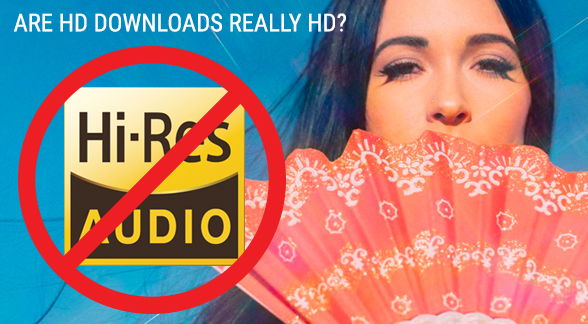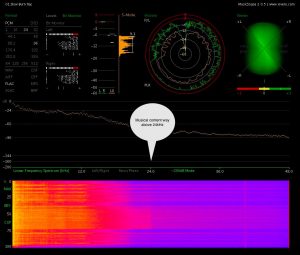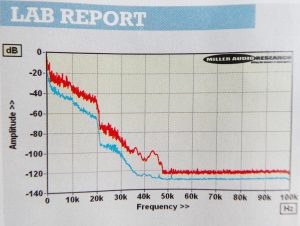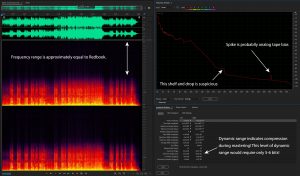Are New HD Downloads Really Hi-Res Music?
I admit to spending too much time cruising FB. And too many of my FB friends and groups are audio related. When I see a post or comment that tweaks my sensibility, I am not shy about posting a comment or linking to a counter argument. During one such discussion yesterday, I made my usual statement that virtually ALL content available on so called “high-resolution” download sites doesn’t qualify as high-resolution — at least in my stringent definition. I’ve downloaded and analyzed dozens of albums from a variety of sites (Qobuz, HDtracks, ProStudioMasters etc.), Some of them were older and obviously from analog masters (Cat Stevens “Tea for the Tillerman” and Neil Young’s “Harvest”) while others are newer and produced using digital tools (James Taylor’s “Before This World” and Kacey Musgraves’ “Golden Hour”, which includes her hit “Slow Burn”). And while these albums sound very good — probably the best we’ll ever get — they are produced and engineered to meet the demands of the commercial marketplace. They are mastered to sound loud on the radio, ear buds, smartphones, Bluetooth speakers, downloads, and CDs.
The proprietor of a European high-resolution download site (and just announced “high-res” streaming) has posted some comments that push back on my position. He claims that the files available on his website are “Native 24bit FLAC at sampling rates up to 192kHz. Fully tested verified and analyzed files. No up-sampled, technically manipulated, tweaked or re-encoded treatment!!” However, a review of the album by Paul Miller in his magazine HiFi News reports, “The download may light the 96kHz LED on your DAC, and appear as ’96kHz’ on your PC/Mac music software, but spectral evidence suggests it’s largely upsampled from 44.1kHz (CD) with aliasing distortion above 20kHz.” As you would expect, the online exchange continued with additional evidence and arguments.
Then the founder of the online service revealed something that I hadn’t heard previously. He commented, “This album is strategic release from the record company and we can not deny the release! Sometimes it is difficult to evaluate the situation. Strategic release we have to put online!” Wow! I interpreted this to mean that the licensing agreement he has with MCA Nashville — or the parent company MCA Universal — mandates that the site offer this “strategic album” regardless of whether it qualifies as a true high-resolution album or not. All of the voodoo “tested and verified” stuff at this site and others goes out the window if they “have to put (it) online.” How are consumers supposed to know what is and isn’t a “strategic release”?
Additional comments had the founder posting an analysis of the “Slow Burn” track (and others) to refute the assertions made in HiFi News. Here’s his posted image from the program Sound Mirror:
This is the track “Slow Burn” by Kacey Musgraves as provided by the high-res download site. [Click to enlarge]
I find it odd that the “text balloon” is strategically placed right at point where the spectral line dips. And the obvious purple vertical line at around 40 kHz ISN’T reflected in the plot line to the right of the “text balloon” as expected. Was this plot altered or just the result of a poor tool?
Here’s the analysis that Paul Miller provided in his publication HiFi News:
Notice the steep drop just above 20 kHz. [Click to Enlarge]
Curious how the two plots don’t match — they should. The steep drop at just above 20 kHz — like an upconversion would show — is obvious in the HiFi News plot. Another aspect of Paul’s spectra is the flat line from 48 kHz to 96 kHz. The file he analyzed has a sample rate of 192 kHz. However there is no audio information above 48 kHz and no musical information above 24 kHz. Why would anyone feel better about this 192 kHz file over the original 48 kHz version? Consumers are being asked to pay for empty data or just noise.
I wanted to do the analysis of the same track myself so I downloaded the same album from HDtracks (I actually became a fan of Kacey after seeing her on SNL) and ran “Slow Burn” through my preferred analysis tool Adobe Audition. Here’s the information I extracted:
The “Slow Burn” track showing the spectral balance in the lower left hand corner, the linear plot of amplitude vs. frequency in the upper right, and the dynamic range of the tune in the lower right. [Click to Enlarge]
My analysis closely matches the one from HiFi News except the sample rate of my download is 96 kHz not 192 kHz. I annotated the various sections of the Audition page to highlight some area of interest. The amount of ultrasonic information is very light and doesn’t appear to be music partials. The steep drop at 24 kHz means that the original was captured at 48 kHz (Nyquist of 24 kHz) and the abrupt spike at 40 kHz is most likely the bias frequency of an analog tape machine — or it could be some other artifact (I’ve seen automation systems create similar intrusions). Most notable — and something that is not addressed in the first Sound Mirror image — is the very narrow dynamic range of this tune. It’s not at all surprising that the mastering stage of a contemporary country/pop tune has been heavily compressed. Having 24-bit containers with a mere 5-6 bits of dynamic range is quite common. The -10.13 LUFS means that this track doesn’t use the full potential of 24-bits (however, most releases follow this model).
So who are we to believe? The proprietor of a so called “high-res” download and streaming service or Paul Miller from HiFi News? My investigation confirmed Paul’s analysis AND affirms my position that virtually ALL high-resolution music offered as streams, MQA, or downloads is not high-resolution. It doesn’t seem to matter whether the content is 50 years old or recorded more recently. The engineers that I know and speak with are still recording at 48 kHz/24-bits. There’s very little incentive or benefit to go any higher knowing that the final master will have less fidelity than a CD.
Should we abandon high-resolution downloads or streaming? If you have the money and feel better getting a big bit bucket full of the same fidelity we get from the original or vinyl LP, then keep spending your money on expensive “high-res” audio. I gave up that pursuit long ago.
+++++++++++++++++++++++++++++++++++++++++++++++++++++++++
PS Many readers have written and asked for the credentials to the FTP site so they can participate in the High-Res Challenge. Be patient. The server can only accommodate 7 people at a time. If you get locked out, try again later. I will be putting a new page on this site to collect responses. Stay tuned.





Hi Mark,
Sad that the whole High Resolution Audio movement became just another con designed mainly to separate the customer from his dollars. The honest products on the market such as yours are so few and far between as to be almost invisible in a forest of misrepresented ripoffs. High End Audio seems hell bent on self destruction at every turn.
> the abrupt spike at 40 kHz is most likely the bias frequency of an analog tape machine
Mark, I’m doubtful of this.
The frequency is too low.
I suspect some other artifact is responsible for the observed 40kHz noise.
I’ve seen automation intrusions at about this frequency. What is the lowest bias frequency? I thought some of the machines I grew up with had 50-120 kHz? But you’re the expert.
Those spectrum graphs remind me of Pioneer’s “Legato Link Conversion”, which claimed to extend the audio bandwidth of ordinary CDs up to 40 kHz by allowing some aliasing to get through the filter. Then they added “Hi-Bit” which “re-quantized” 16-bit CD audio to 20-bit resolution. I wonder if golden-ears audiophiles would be able to tell the difference between a regular CD doctored-up in this manner, and an MQA recording?
The addition of aliasing wouldn’t accurately reflect the musical partials present in that last octave but would light up the ultrasonics. Don’t get me started on MQA. When audiophiles and reviewers claim to hear differences of standard-resolution MQA encodes, I have to just accept that the MQA investors are winning at their marketing push.
I’m sorry, it’s not clear from your article if you base your conclusion that “My investigation confirmed Paul’s analysis AND affirms my position that virtually ALL high-resolution music offered as streams, MQA, or downloads is not high-resolution.” is based on the one test you performed, or based on some sort of statistically significant number of tracks analyzed in the same manner. Your statement is likely to be true for historical reasons, but you don’t spell out the basis for your conclusion. Thanks.
John, I have purchased and downloaded many dozens of “high-resolution” files AND I know the provenance of most of the commercial recordings offered on these sites. They come from recordings done on analog multitracks decks mixed to yet more analog machines. In addition, the dynamics mastering that occurs (I mastered hundreds of albums during my 13 years as a mastering engineer) during the final stage of production severely limits the need for anything more than 16 bits…even 8 bits.
Ive recently purchased a few hi res downloads, and generally found them disappointing. So I started digging and came to a similar point of view (but with no industry knowledge).
What Im after is to be able to play the best quality music in my living/listening room with as little fuss as possible. I am happy to pay for that privilege.
As far as I can tell from poor to good quality container wise:
Vinyl,
Redbook CD,
HiRes FLAC (88.2Khz 24bit PCM and above).
However it appears to me, for my application: dedicated quite room, with a half decent system. Vinyl is the only format that is mastered with me in mind. However Vinyl is deeply limiting (rumble filter required, storage requirements, easy of damage, high noise floor, wear and tear, slow to change record etc etc).
HiRes downloads seems to be used to boost short term profit over long term stability and customers best interests.
So my options appear to be, suck it up and just buy CDs where the loudness war is killing quality. Get myself a decent deck and ADC then digitally copy Vinyl to a suitable container (slow, and painful to get track timing information etc).
I was hoping for a third option, where I could get music mastered for higher end systems, in a suitable digital format. The only way I can do this is by getting into Jazz, which I can appreciate but in the main wouldnt say I enjoy. Any Ideas? Is the market for high quality music really that closely overlapped with the market for vinyl, that that is the only segment that has profit to it? I’d happily subscribe to somewhere that independently assessed HD downloads, to highlight the actual gems out there! Thanks
Yes, the “high-resolution” downloads and streams that you’ve experienced are transfers of the over compressed masters. All we can hope is to get the best available master in high-resolution digital form. Some transfers are better than others…and there is no way to know. Are they worth the premium prices? Probably not. The record companies are not interested in fidelity. They will always opt for the version that makes more money.
Hi Mark;
I recently discovered your blog and am both captivated and disappointed. Captivated by all the myth busting you provide and disappointed that I can no longer trust any of my sources of HD downloads. How does the average consumer like myself know what they are getting? Is anyone other than yourself critically analyzing these files and if so who? Are there a few simple key words or descriptions that will allow someone to pick out what is just a really good copy of poorly recorded music from something that truly will sound amazing?
Just came across your site and find myself reading your blogs nonstop. On this point, I have downloaded a number of high resolution albums, but at my age cannot discern a difference in the fidelity, so I limit myself to buying and ripping CDs, notwithstanding the compression so prevalent in music these days. I would, however, be willing to pay a premium for uncompressed files, simply for the experience of hearing the music the way the artists intended. Artists should press their labels to release their music in uncompressed formats for those of us who listen more critically. That at least would be an honest basis for upcharging the content.
Jim, thanks for coming by. I haven’t been writing nearly as much as I used to but welcome to the site. I’m sure there’s plenty to read in the over 1100 articles I’ve penned. And don’t overlook my book, “Music and Audio: A User Guide to Better Sound“.